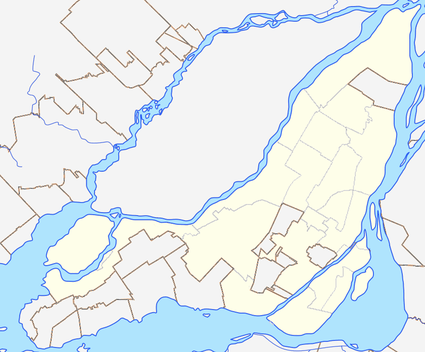Cité du Multimédia
The Cité du Multimédia is a neighborhood in Montreal, Quebec, Canada, located between Old Montreal, Griffintown and Downtown Montreal. The neighborhood is the result of a vast real-estate project launched by the Quebec government in the late 1990s which redeveloped abandoned nineteenth century industrial buildings into a business cluster for information technology companies.
Cité du Multimédia | |
|---|---|
 Cité du Multimédia Location of Cité du Multimédia in Montreal | |
| Coordinates: 45.498889°N 73.5575°W | |
| Country | Canada |
| Province | Quebec |
| City | Montreal |
| Borough | Ville-Marie |
Groupe Cardinal Hardy and Groupe Provencher & Roy architectes collaborated on the district's urban design.[1]
History
The Société de Développement de Montréal possessed land holdings dating back to the Doré administration's failed Quartier des Récluses initiative, in which lands were bought by the SIMPA to make way for the project. In exchange for handing this over, the SDM gained a minority stake in a joint venture with the real estate arms of the Caisse de dépôt et placement du Québec (CDPQ) and the FTQ Fonds de Solidarité to fund the construction of the Cité, which occurred in eight phases, with additional phases having been planned. The Parti Québécois Bouchard Government of Québec then gave payroll tax credits to employers for moving to the new Cité du Multimédia buildings.
After the bursting of the dot-com bubble, and the elimination of tax incentives for information technology jobs in the district by the Liberal government of Jean Charest in 2003, phase 9 and others were cancelled, and the structures were sold by the joint venture to the private sector.
Economy
Many high-tech companies are still located in the area, while phase 8 is occupied by the municipal government. The property values in this part of Montreal are very high. The neighbourhood has 6,000 workers, and an average salary of $73,000 per year. This figure is almost 25% above Montréal's average.
Controversy
Then-finance minister Bernard Landry had been criticized by members of Montreal's real-estate community and some high-tech entrepreneurs when Finance Ministry programs enticed companies to relocate to Cité Multimédia and the Cité du commerce électronique downtown in order to receive tax assistance.[2] In response, Landry announced the creation of CDTIs located in mid-sized cities throughout Quebec, and later the installation of technology clusters in rural areas, such as the Technoparc Rolland in Sainte-Adèle, Quebec.
The Cité du Multimédia was also put under investigation in the context of the Charbonneau commission inquiries.[3]
In 2019, the Cité du Multimédia was under controversy again when Montreal Mayor Valerie Plate proposed naming the Griffintown REM station "Griffintown-Bernard-Landry" due to its proximity to the Cité du Multimédia. This sparked outrage from Montreal's Irish community, who were reeling at the time due to a Famine cemetery disturbance at the Black Rock by the REM, who disinterred over 15 skeletons to insert a monorail pylon into the burial ground. The international media reaction was very negative, but the Mayor refused to back down. [4]
References
- Chodikoff, Ian (October 2003). "Strategic Urbanism". Canadian Architect. Business Information Group.
- MacDonald, Don. "Tax credit targeted at boosting e-business". Montreal Gazette. Canwest. Archived from the original on 2012-11-04. Retrieved 2008-04-13.
- "Archived copy". Archived from the original on 2014-05-23. Retrieved 2014-05-23.CS1 maint: archived copy as title (link)
- "OTL Blog » Blog Archive » An Open Letter from a City of Montreal Ambassador to Mayor Valerie Plante RE: Griffintown REM Proposal and Negative International Reaction". Retrieved 2020-01-20.
External links
- Allied Properties REIT - Cité Multimedia
- Rose, Owen (2007-11-18). "Montréal Architecture (No.6)". URBANPHOTO. Retrieved 2008-03-28.
- Montrealbits.com: Cité Multimedia